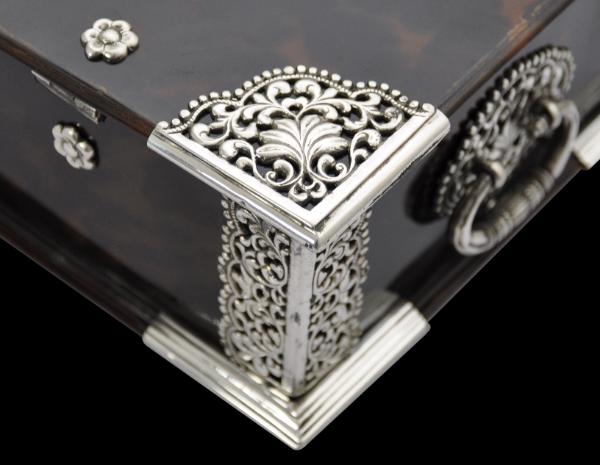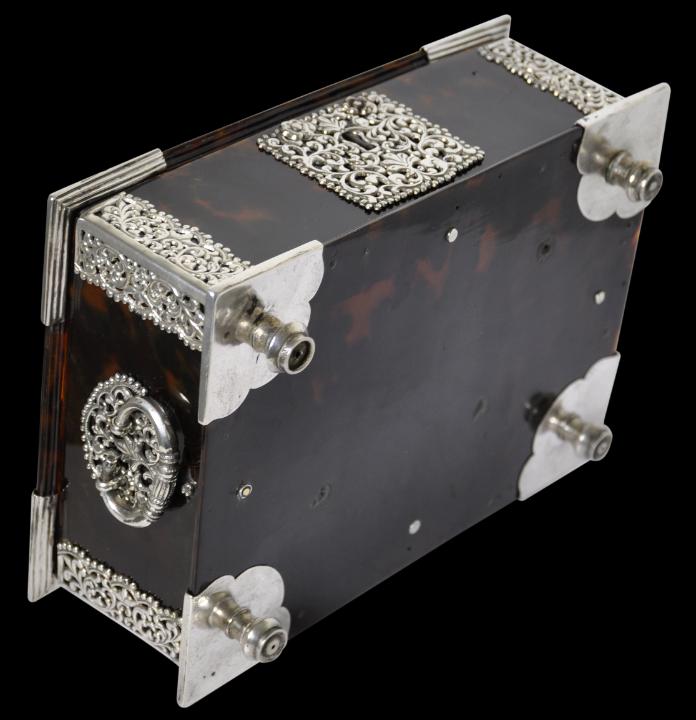
Dutch Colonial Betel Box
Dutch Colonial Tortoiseshell Betel Box with Silver Mounts
Batavia, Dutch East Indies
18th century
length: 19.8cm, depth: 14.2cm, height: 8.2cm
This superb betel box is of tortoiseshell panels and fine, open-work silver mounts.
The top cover is hinged and decorated with a central open-work silver plaque with rococo-inspired floral and scrolling leaf patterns. The four corners are similarly embellished, as is the elaborate key plate at the front. Flower-shaped plaques cover the rivet heads thereby disguising the construction of the box.
The interior of the box is fitted tortoiseshell dividers into which smaller boxes to hold the various separate elements of the betel quid would have been placed.
The internal hinge flanges are as elaborately pierced with rococo leafy motifs as silverwork on the exterior of the box.
A silver chain inside the box extends from the lid to the base, and provides support for the lid when it is open.
The box sits on four silver baluster-form legs. Fine solid-cast and engraved silver handles are attached to each side, over open-work silver handle plates.
The Javanese habit of chewing betel was adopted by the local Dutch and exquisite boxes to hold the nut, the betel leaf and the other accompaniments were commissioned by the Dutch. The Dutch realised early on how important betel was to the indigenous people and how it was an essential part of hospitality including with the indigenous rulers. They quickly incorporated betel use with their dealings with local elites. Paintings that show the wives of Dutchmen at the time often show betel boxes prominently displayed. One such seventeenth century painting by J.J. Coeman which today hangs in the Rijksmuseum shows Batavia’s Cornelia van Nieuwenroode with her husband Pieter Cnoll and two of their nine daughters, one of who is shown holding a jewelled betel box (Gelman Taylor, 2009, p. 42).
The fashion for luxurious betel accoutrements and other finery saw the governor-general in Batavia Jacob Mossel issue a decree in 1754 stating that only the wives and widows of the governor-general, the director-general, members of the Council of the Indies and president of the Justice Council were permitted to
use gold or silver betel boxes adorned with precious stones, (Zandvlieyt, 2002, p. 206).
There is one small, fine and barely-visible crack to the tortoiseshell, but otherwise the box and the silver mounts are all in excellent condition. The tortoisehell is lustrous and the silver has a fine patina.
References
Eliens, T.M., Silver from Batavia/Zilver uit Batavia, Gemeentemuseum Den Haag/W Books, 2012.
Krohn D.L. & P.N. Miller (eds.),
Dutch New York Between East and West: The World of Margrieta van Varick, Bard Graduate Center/The New York Historical Society/Yale University Press, 2009.
Veenendaal, J.,
Furniture from Indonesia, Sri Lanka and India During the Dutch Period, Foundation Volkenkundig Museum Nusantara, 1985.
Veenendaal, J.,
Asian Art and the Dutch Taste, Waanders Uitgevers Zwolle, 2014.
Voskuil-Groenewegen, S.M.
et al, Zilver uit de tijd van de Verenigde Oostindische Compagnie, Waanders Uitgevers, 1998.
Provenance
UK art market
Inventory no.: 2731
SOLD













